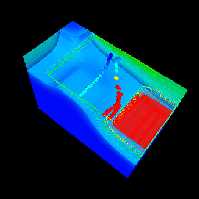|
|

Nanomaterials Team
Dr. Craig J. Scott, Kofi Nyarko
We will demonstrate the development of new tools and techniques to create better ways for
students and researchers to understand and interact with three-dimensional computational
electronics datasets. We apply the latest advancements in scientific visualization,
high-performance computing and virtual environments to study electronic material properties,
semiconductor device performances, and circuit behaviors. Our use of immersive tools,
such as the Immersadesk allow students and researchers to gain insight through feedback
from visual and/or audio cues using a "walk-through" perspective. Presently, this work
supports ongoing DoD sponsored studies involving scalable, efficient modeling and simulation
of complex electronic structures, circuits and novel materials.
We are developing a visualization application that allows one to use AVS Express with the
Immersadesk. AVS express is one of the preeminent commercial scientific/ engineering
visualization software programs that runs under both UNIX and Windows operating systems.
This program uses an object oriented approach that allows rapid prototyping and testing of
complex visualization techniques with minimal programming. By integrating the controlling
wand and head tracker from the Immersadesk virtual environment, one controls an AVS/Express
scene with fluid, intuitive controls designed to enhance the illusions of complete three
dimensional immersion. To further illustrate the usefulness of this tool, we will show several examples of how to
visualize various electronic structures such as metal oxide field effect transistors (MOSFETs),
bipolar junction transistors (BJTs), and high electron mobility transistors (HEMTs). These
electronic visualizations will show the true behavior and locations of the currents, potentials,
and electric fields in the devices as the geometry, material properties, and biasing conditions
are changed.
Robert Dutton, 415-723-4138
dutton@stanford.edu
uravaiol@uiuc.edu
David Ceperley, 217-244-0646
ceperley@ncsa.uiuc.edu
Morgan State University
Department of Electrical and Computer Engineering
Baltimore MD
cjscott@eng.morgan.edu
http://dee.eng.morgan.edu/~web
![]()
back
![[Alliance]](http://www.ncsa.uiuc.edu/includes/footer-alliancelogo2.gif)
![]()